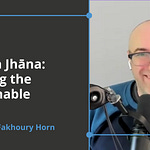What is Access Concentration?
This is the question I want to bring forward in this talk.
I recorded something on this topic many years ago—too many, honestly, to comfortably admit. At the time, I was working on a project that was essentially a secular meditation app. That’s basically been the through-line of my career: building and teaching through these kinds of projects. The app was called Meditate.io, and we had a course titled Concentration Meditation. In it, we aimed to explain the basics of how concentration really works.
That course now lives on in The Jhāna Community under the name Concentration 101. It shares some really good foundational ideas, one of which is the concept of Access Concentration. I found this idea so useful in my own Buddhist meditative practice that I really wanted to bring it into a more secular context. There’s a YouTube clip that gives my best simple explanation of what Access Concentration is, and I won’t go too deep here since that recording already exists. That’s the beauty of recording something—you don’t have to keep repeating yourself.
But here’s the short version of how I understand it:
Access Concentration is when the object of your focus—whether it’s the breath, the body, a sound, a visual orb, a mantra, or anything else—moves into the center of your attention. It shifts into the foreground, and everything else fades into the background. That background doesn’t disappear entirely; distractions and thoughts may still be there, but now they’re peripheral. The object of your focus becomes primary.
This shift is important. It’s a turning point in practice when your attention starts to settle and stabilize. Of course, we can fall out of access. Some people think they’re only in access concentration if they maintain it the entire time they’re sitting—but that’s a much deeper, more stable version that usually takes time to develop. Unless you’re a natural at this—and few are—it takes consistent effort.
In any given moment, if your meditation object is the main thing in your attention, you’re in access. And sure, distractions will pull at you—that’s normal. You fall out of access, and then you come back. Return to the breath. Be with it.
At first, the breath might not hold your full attention. Maybe it gets 50%, then 30%, then 20%, then something else pulls at you. It’s a dynamic process. In my experience, concentration becomes more fluid and interactive the deeper you go. But at some point, your focus stabilizes: more than 50% of your attention is on the breath. It begins to draw you in—it has gravity. You want to give it more attention. There’s interest. There’s intimacy.
In the traditional Buddhist framework, this state is called Access Concentration because it’s the doorway into the jhānas. You can’t access the jhānas without first stabilizing in access—at least, according to later Buddhist sources. And here’s a side note for the Buddhist nerds out there: the term Access Concentration doesn’t show up in the earliest teachings. It came later—about a thousand years after the Buddha’s time.
Imagine a thousand years of mostly-male monastics meditating, likely trying to outdo each other, and eventually producing this giant meditation manual called the Visuddhimagga, or The Path of Purification. That’s where we find the term Access Concentration, described in the section on concentration—one of three main sections in the book.
According to that model, you reach Access Concentration just before entering jhāna. The Visuddhimagga describes 40 different objects that can lead to access, though I doubt that list is exhaustive. (Hopefully someone caught that Pokémon reference. I know Buddy did.)
So, what is Access Concentration again?
Another way to understand it is this: it’s one of the five jhāna masteries. To master meditation, you have to be able to access the states you want to enter. In other words, Access Concentration is the ability to get to the object—mentally and emotionally—so you can begin to absorb into it.
If we want to use a numerical analogy: Access is when more than 50% of your attention is with something. You’ve entered into relationship with it. And from there, you can deepen that relationship, becoming more absorbed.
In the KASINA meditation app I’ve been developing, there's a visual orb that users can move toward them on the screen. As it moves closer, it fills the screen—you merge with it. That’s what happens with the breath, or love, or the body, or even not-knowing. You become one with the object. That’s the beginning of jhāna.
And the sequence of jhānas, from one to eight, describes how that relationship deepens and evolves. First, the merger is blissful—like falling in love. It’s magical. But over time, that intensity cools, and you settle into a more steady connection—like the second jhāna and beyond.
So, to even enter into that evolving intimacy, we need access. The Visuddhimagga says there are 40 objects that work for this, which implies there are many things that don’t. But I actually disagree with that. I think you could potentially access and merge with anything. But the real question is: why would you want to merge with, say, terror?
Could you handle becoming one with being terrified? Some people love horror movies. I’ve never understood that—it feels like life is terrifying enough. But for those people, maybe horror is a doorway. Maybe terror is their access point.
Okay, so here’s a simple practice to support this:
May concentration arise.
That’s the practice. Just wish for concentration to arise.
Who are you wishing it for?
Start with yourself. That’s why you’re here. Get in touch with the sincerity of that wish—why it’s important to you. Maybe you want to be able to focus better on your relationships, your work, the way you show up in the world. Maybe you want to be healthy, to remember what matters. Concentration helps with that.
So: May concentration arise—for me.
And then extend it out: May concentration arise for the people I care about.
Because when the people around you are focused and well, it affects you too. It creates a feedback loop of clarity and joy.
Then go wider: May concentration arise for everyone.
Even knowing some will use it for harmful ends, trust the whole. Most won’t.
And then: May concentration arise for all beings on Earth.
For all beings to be focused on what’s most important to them.
Even broader: May concentration arise for all beings, everywhere, throughout all time and space.
May all of reality concentrate on what matters most to itself.
Wishing concentration for everyone.
The Jhāna Community
The Jhāna Community is a community of practice dedicated to the art of deep meditation. Check out our 6 new weekly jhāna groups beginning in June:















